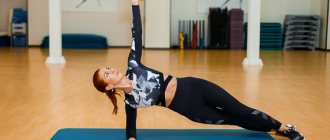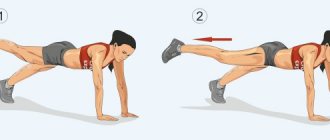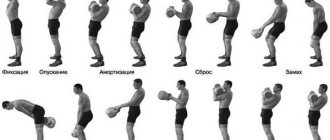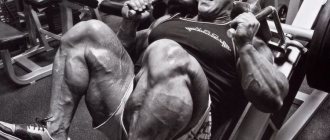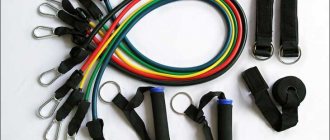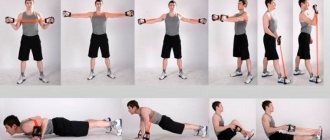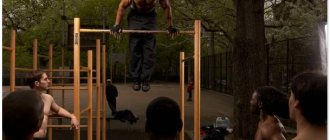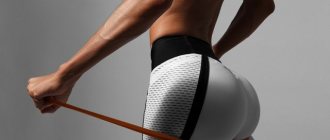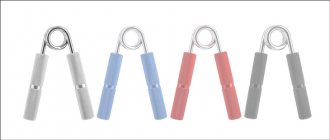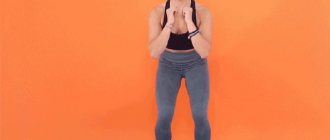For the exercises presented below, both rubber bands and regular expanders with handles are suitable - choose what is more convenient for you.
Some of the exercises below need to be performed with short resistance bands. If you don't have these, just skip these exercises. I tried to do them with long ribbons, but it was very inconvenient, almost impossible.
As for the resistance of the bands, choose the load according to your capabilities. Aim for three sets of 10–15 repetitions of each exercise. For training to be effective, the last repetitions must be difficult.
Exercises with an expander
We will look at the most popular exercises with an expander. To do this, we will divide the body into main muscle groups: chest, back, shoulders, biceps, triceps, legs, abs. To perform some exercises, you will need to secure the expander to something at the top or bottom. And if there are no problems with this in the gym, then they can arise at home. Some people attach the expander to pipes, batteries, or press it against a door. But all this is not very safe, and can lead to various unpleasant situations. Therefore, it is better to purchase a special bracket and screw it into the ceiling.
Contraindications for exercise
Exercises with an expander do not benefit everyone; there are exceptions. Danger also threatens those who exercise incorrectly: skip the warm-up, neglect advice on performing the exercises correctly.
During training, tension or rupture of the ligament or muscle tear may occur. Before starting physical activity with an expander, consult your doctor for any contraindications.
You cannot train with an expander if:
- Diagnosed diabetes mellitus.
- Diseases of the cardiovascular system.
- Abnormal blood pressure levels.
- Unhealed lesions on the skin, wounds.
- Infectious skin diseases.
- Diagnosed oncology of any stage.
- Joint diseases.
- Thin walls of blood vessels and capillaries that can burst during heavy physical activity.
Violation of safety precautions during training leads to injuries, pain, etc. Exercising with an expander for the above indications disrupts general well-being, worsens a person’s condition and progresses the development of the disease.
Therefore, consultation with a specialist before starting any active physical training is mandatory.
For babies
Bench press with expander
This exercise is very familiar to any person. Basically, everyone is used to performing it with a BARBERL or DUMBBELLS. But in our case, we will use a rubber expander. This exercise will help work the pectoralis major muscles.
Performance:
- Lie down on a bench press or place your upper torso on a chair and place your feet on the floor.
- Slide the resistance band under the bench and grab its edges.
- Unlike working with dumbbells, we will start the exercise from the bottom point.
- Exhale and push your arms up. There is no need to bring them together.
- We take a short break, giving the breasts the opportunity to work statically.
- And while inhaling, bend them at the elbow joints, returning them to their original position.
Watch your technique. At the top point, be sure to pause, giving the chest the opportunity to compete with the force of compression. Unlike classic bench presses. The expander makes it possible to maximally load the pecs at the top point. Some use it in conjunction with a barbell, attaching it to its edges. This gives you a double advantage.
Lying arm raises with an expander
Another exercise that should be in your arsenal. It is analogous to ARM FLIES WITH DUMBBELLS, and helps to work out the pectoralis major and minor. It also stretches muscle fibers. Making our pecs visually even larger.
Performance:
- The principle of execution here is almost the same as in the previous exercise.
- We lie down on a bench or chair.
- We push the expander under them and take hold of its edges.
- We bring our hands together.
- As you inhale, we begin to move them in different directions, stretching the pectoral muscles as much as possible.
- At the lowest point, take a short pause.
- Then, while inhaling, we begin to move the edges of the expander towards each other, until they are completely brought together at the top point.
It is very important that your movements are controlled. Don't relax when breeding. If you find it difficult to perform the exercise, take a less rigid resistance band. And most importantly, do not turn the fly into a bench press. At the top point, the arms should be slightly bent at the elbow joints.
Resistance push-ups
This is the most accessible basic exercise. To perform it, we only need an expander and a surface against which we will rest. Performing PUSH-UPS WITH WIDE HANDS will allow us to shift the load on the pectoral muscles. The expander in this exercise will act as an additional weight. If we want to modify the exercise a little, then we can put our feet on a hill. This will shift the load from the middle of the pecs to their upper part.
Performance:
- Take the expander by the two ends in your hands. Throw it behind your back.
- Take a lying position, pressing the ends of the expander with your palms to the floor.
- As you inhale, bend your arms at the elbow joint and lower your body down almost until your chest touches the floor.
- Stay in this position for 1-2 seconds.
- Then, as you exhale, straighten your arms and push yourself off the floor.
When lowering, do not relax your arms, especially when working with stiffer resistance bands. While moving, keep your body straight. Do not lower or lift your pelvis. Try to feel the work of your pectorals in each phase of the exercise.
How to choose the right elastic band and where to buy
To perform different types of exercises with a gymnastic tape, you may need different equipment. Therefore, you should purchase them in sets at once. The cost of inventory is low, it usually varies depending on the number of items in the set, quality and manufacturer. According to coaching recommendations, beginners should take a closer look at mini-trainers with minimal density; experienced athletes should take denser ones.
You can buy an expander band at any sports store. But you can often find it in regular retail outlets. All products have several levels of elasticity. Anyone can choose the best option for themselves, based on the characteristics of their own physical fitness.
Most often, such equipment is presented in three types of density: soft, medium and hard. Each level of elasticity corresponds to a specific color palette.
But relying solely on color when choosing is the wrong decision. Different manufacturers - different markings. Therefore, it is much safer to study the characteristics of products before purchasing.
When buying an elastic band for fitness, you need to remember the following color gradation:
- Yellow - assumes the lowest load, is the best option for beginner athletes;
- Red, green - the next level, medium degree of hardness.
- Lilac, blue, violet - the hardest shells with high resistance, suitable for people with well-pumped muscles.
The length should be 1.2 m. The longer the simulator, the greater the number of movements it will allow you to perform. A very long expander can be folded in half, thereby increasing the load. The optimal projectile width is 15-20 cm.
When purchasing a product, pay attention to the quality of the material. The higher the quality characteristics, the longer the equipment will last, and training with it will be more effective.
For the back
Bent over expander row
Let's start with basic exercises aimed at developing back thickness. It is an analogue of the BAR ROLL IN THE INCLINE. Depending on the angle of inclination, we can shift the load from the top to the bottom of the latissimus muscles. Due to the fact that we perform rows with both hands, we can take more rigid expanders. This will increase the load on the working muscles. As a result, they will begin to grow.
Performance:
- Stand with both feet in the middle of the expander and take its edges in your hands.
- We move the pelvis back and tilt the body forward. For greater stability, bend your knees slightly.
- The back should be straight, there should be a slight arch in the lower back, and the gaze should be directed forward.
- As you exhale, we begin to bring the shoulder blades together and pull the edges of the expander to the lower abdomen (the area under the navel).
- Hold this position for a short time to maximize the load on the latissimus and rhomboid back muscles.
- Then, as you exhale, we return to the starting position.
Perform deadlifts by contracting your back muscles rather than bending your arm. To do this, focus on squeezing your shoulder blades together and lifting your elbows up. Take your time, do the exercise at an average pace. If you have done this deadlift before, only with a barbell. Then at first, performing it with an expander will not be familiar. But this is a temporary effect and it will pass quickly.
Vertical thrust
And again, a basic exercise for training your back. Basically, VERTICAL PULLING is performed in a crossover. It is aimed at increasing the width of the back. To complete it, we will need to secure the expander to something. I have already written about this earlier. We can also work on different areas of the back and increase the range of motion. This is achieved by positioning the edges of the expander relative to each other. The closer they are, the greater the amplitude will become and the load will fall on the bottom of the lats. A wide stance uses the upper part of the lats. But this will reduce the amplitude.
Performance:
- Secure the middle part of the expander to the bracket installed at the top. Or press it against the door (assuming your doors are secure).
- Grab its edges with your hands and kneel down.
- As you exhale, pull the edges of the expander down.
- As you inhale, return to the starting position.
Beginners will find it difficult to feel the work of their back at first. But there is a proven method. You need to focus on lowering your elbows rather than bending your arm at the elbow joint. And then the biceps will not dominate the exercise.
Horizontal thrust
Another exercise option for the back that helps develop its thickness. It is performed while sitting on the floor. It is analogous to the LOWER BLOCK ROD. As in the vertical row, we also increase the amplitude of movement by bringing the edges of the expander together. A kind of close grip deadlift.
Performance:
- Sit on the floor. Extend your legs forward.
- Take the expander by the edges and secure the middle to your feet.
- Straighten your back, lean your chest forward a little. Arch your lower back.
- As you exhale, pull the edges of the expander towards the middle of your abdomen. To perform the movement, you need to bring your shoulder blades together.
- While inhaling, we return to the starting position.
Before you start, check that the expander is securely fastened to your feet. To be calmer, you can rest them against the wall. This is very important, as the expander can come off in your face. Watch your movements. Do not bend your legs or round your back while doing this.
What is a simulator and what is it intended for?
This exercise machine is easy to use, but at the same time it is an effective tool for strengthening muscles. Exercises with an expander band at home make your body resilient and flexible. It is easy and safe to train with it, since during training the joints and ligaments are not subject to excessive stress.
The resistance band is the right choice for strength training and fitness. Thanks to its small size, efficiency and versatility of use, it will certainly become one of the most popular in the collection of equipment for home training.
Shock absorber tapes are made from latex (rubber) in the form of a wide, non-loop “scarf”. The primary task of such sports equipment is to create resistance. The thicker and denser the machine, the more difficult it is to perform the exercises. Therefore, elastic bands are ideal for anyone who wants to get rid of extra pounds, work on developing coordination, endurance, and build muscle mass. Any goal towards which efforts are directed will become achievable thanks to such sports equipment.
For triceps
Extension of arms from behind the head
This exercise will help develop all three heads of the triceps with a slight emphasis on the long head. It can be performed with one hand or with both at the same time. In the world of bodybuilding, these EXTENSIONS are DONE WITH A DUMBBELL.
Performance:
- Stand in a separate line. That is, one leg is in front and the other is behind.
- Attach an expander to your back foot.
- Take its edges in your hands and lift them above your head.
- As you inhale, bend your arms at the elbow joints and lower the edges of the expander behind your head.
- Take a short break and stretch your triceps as much as possible.
- As you exhale, straighten your arms and return to the starting position.
Watch the position of your elbows; they should not diverge too much to the sides. Keep them as close to each other as possible. Work exclusively by contracting the triceps. Don't help yourself with your feet.
Bent press with expander
I think many people are familiar with this exercise. This is a modified version of the CROSSOVER DOWN PRESS. Allows you to work your triceps in isolation. Most of the load will fall on its lower part. And by turning the hand from a neutral position to a pronated one, we can shorten the long head as much as possible. You can perform the exercise with one hand or two at the same time. Also, it is possible to use a variety of grips: neutral, pronated (palms down) and supinated (palms up).
Executions:
- Attach the middle part of the expander to the bracket or press it against the door.
- Grab the ends with your hands and take a few steps back to stretch the resistance band.
- Press your elbows close to your body, lean forward slightly and bend your knees.
- At the exit, we extend our arms by contracting the triceps. At the same time, we turn our hands with our palms down and spread them slightly to the sides.
- We take a short break and return to the starting position.
Watch your elbows. They should not diverge to the sides when the arms are extended. Don't help yourself with all your weight. If you feel that the exercise is difficult. Then change the expander.
Development of brushes
To date, several types of simulators have been developed for the development of the hand. These include:
- rubber rings of different hardness;
- butterfly, where two slats are connected by a spring;
- made of steel.
They all differ in their compression rigidity. As soon as repetition of exercises begins to be easy, you need to switch to a more rigid structure.
Exercises with a wrist expander for men are well suited for the development of the hand and forearm.
They are a good help for self-development and professional sports. Example workout:
- within 1 minute, use a brush to squeeze the expander 100 times;
- 3 minutes break;
- 3-5 repetitions of such approaches for each hand.
After such a workout, you will need a 24-hour break to exercise your hands. The advantage of such products is their safety and large variety.
For biceps
Arm curls with an expander
I think everyone knows that the most common exercise for biceps is the BELL BAR CURL. So we will do something similar only with an expander. There is an opinion that a change in the position of the hands relative to each other. May change the tension on each biceps head. A narrow arrangement puts more stress on the long head, and a wide one on the short one. But you won't feel much of a difference. Therefore, this moment can be used to diversify the exercise.
Performance:
- Stand on the middle of the expander with your feet.
- Take its ends in your hands.
- Lean forward slightly and bend your knees. This will make your position more stable.
- Press your elbows close to your body.
- As you exhale, bend your arms by contracting your biceps.
- We take a short pause in the upper position and slowly straighten our arms.
Do not lift your elbows up when bending your arms. Perform the exercise only by contracting your biceps. Don't swing or use your leg muscles.
Reverse grip curls
To fully develop the arm muscles, you need to train another muscle. We are talking about brachialis. It is located under the biceps and is responsible for the same function, bending the arm at the elbow. A reverse grip (pronated) allows us to exclude the biceps muscle from the exercise, so we can load the brachialis more heavily.
Performance:
- To perform reverse curls, it is best to use an expander with handles.
- The starting position is the same as in the previous version.
- We stand in the middle of the expander and take its edges in our hands with a pronated grip.
- As you exhale, bend your arms at the elbow.
- We take a short pause, and while inhaling, we straighten them.
Do not bend your arms while doing this. Watch the position of your elbows. They should not extend forward or backward relative to the body.
How to make your workouts more effective?
To enhance the effectiveness of your exercises, it is recommended to have expanders with varying degrees of resistance in your arsenal. It is also very important to follow the correct technique.
In general, the result will depend on many factors. For each exercise, you should carefully select an expander so that its resistance matches the goals of the exercise, your experience and health status.
How to choose the right fitness band for training? Their effectiveness depends on this
For legs
Squats with an expander
When it comes to leg training, the first thing that comes to mind is SQUATS. This is a great exercise to target your quadriceps and glutes.
Performance:
- The beginning is standard for exercises performed while standing.
- We stand in the middle of the expander. We place our legs hip-width apart (slightly narrower than shoulder width).
- We take the edges. We bend our elbows and place them in front of us, so that the expander is behind our forearms.
- The back is straight, there is a natural arch in the lower back. The gaze is directed forward and slightly upward.
- As you inhale, move your pelvis back and bend your knees.
- We take a short pause in the lower position.
- And as you exhale, we rise from the squat.
Watch the position of your knees. In the lower position they should not protrude beyond the toes. While squatting, do not look at your feet. This will make you round up. Start squats with abduction of the pelvis, not bending at the knee.
Become traction on straight legs
Well, where would we be without STANDING ON STRAIGHT LEGS. This exercise helps develop the muscles in the back of the thigh. Which receive virtually no load when doing squats.
Performance:
- We stand in the middle of the expander and take its ends in our hands.
- As you inhale, we begin to move the pelvis as far back as possible, due to which the forward tilt will occur.
- Stretching the muscles of the back of the thigh as much as possible. Exhale and return to the starting position.
While bending over, do not bend your knees. This will shift the load from the thigh muscles to the gluteal muscles. Do not round your back to avoid damaging your spine.
Lunges with expander
This is a basic exercise that allows you to load the gluteal muscles and quadriceps. LUNCHES can be performed in different ways. Taking a step forward and back. This will load the muscles differently. We will consider the technique of only the classic version.
Performance:
- We stand with one foot in the middle of the expander, and move the other one back.
- We take the edges with our hands and bend them at the elbow.
- While inhaling, bend the leg at the knee joint until an angle of 90° is formed in it.
- After taking a short pause and exhaling, straighten your leg by contracting the quadriceps and gluteal muscles.
While performing the exercise, do not lean forward too much. Make sure that your knee does not extend beyond your toes.
